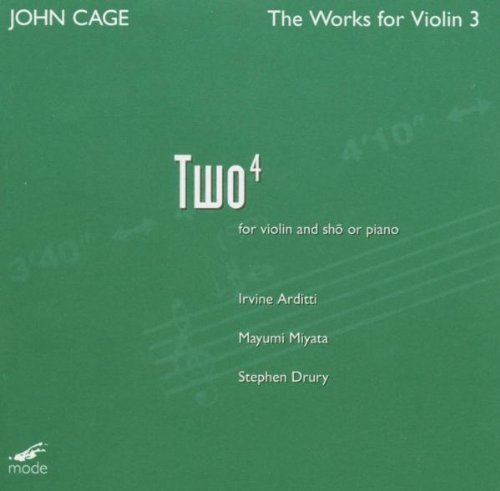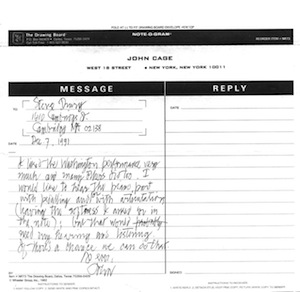WRITINGS
VARIATION
PITCH
STRUCTURE
TIME
John Cage: Two4 for Violin and Piano or Sho
 |
One of Cage's preoccupations in his later years, he once told me, was with the question of a composition's "identity", and how that identity is maintained through radically different performances. In the two performances of the single piece recorded here, that question is raised in ways both subtle and obvious. The choice of piano or sho will fundamentally alter the sound of the music. The sho is a wind instrument used in the gagaku ensemble which provided the traditional court music of Japan. Originally, only fifteen of its seventeen pipes have a reed, each of which produces a single pitch. More recently reeds are sometimes added to the remaining two pipes. The sho sustains and breathes, the piano chimes and begins to fade immediately after being played. The piano sounds a chord with a single ictus, the sho attacks its chords gradually, notes fading in one at a time. When performed with sho rather than piano, the music gives the impression more of blending than diverging. The music for the sho covers its full modern range of seventeen pitches, most but not all chromatically adjacent. A listener to the version with piano cannot help but be aware that those same seventeen notes cover but a small fraction of the complete range of the instrument.
Although the violin's range is similarly restricted, it is also expanded internally – the player is asked to differentiate six microtonal notes between each chromatic step, resulting in a scale of eighty-four tones to the octave! Cage's explicit intention is not a precisely microtonal music; rather he uses this notation as a way of creating uncertainty in the pitch field. In addition, the violin can be asked to sustain its single pitches as long as necessary – for up to a minute and forty seconds. The piano or sho, having more limited sustaining ability (the piano sound dies away, the sho’s chords last no longer than the player's breath), must move through its material much more rapidly, sometimes having as many as eleven chords to move through in no more time than the violin has to hold a single note. The two instruments thus play contrasting roles throughout, in the fields of both pitch and time – the violin generally exploring the infra-chromatic cracks between the piano or sho’s tempered scale; long, single tones against changing harmonies. (In the first performance, at Paul Zukofsky's suggestion, we physically separated the instruments as much as the stage would allow.)
This contrast, giving the impression of two different compositions simultaneously performed, is reinforced when one looks at the individual parts in greater detail. Each player's music is divided into movements. The piano or sho has three movements, the violin four. The divisions do not coincide, nor are there breaks between the movements. The tessiatura of the violin part descends from movement to movement, so that the player is forced onto successively lower strings and the color darkens over the course of the piece. The roman numerals at the beginning of each movement (I, II, III, and IV) are the same notation which signifies to a violinist which string is to be used (high E, A, D, and low G). The piano's three movements appear to have less correlation with the music played (which lies throughout in the same range). A sho player must change instruments roughly every ten to fifteen minutes in order to prevent moisture from collecting on the reeds. This seems to coincide with the division into three movements, each of which have ten fragments or phrases. However, Mayumi Miyata says that the sections were chosen by use of the I Ching, and are unrelated to the change of instruments.
 |
Most of Cage's later works utilize what he referred to as "time-bracket" construction. Individual fragments of music, sometimes consisting of as little as a single pitch, are surrounded by timings indicating the placement of the fragment within the total duration of the composition. These are fixed (play between six minutes after the beginning, end by six minutes and thirty seconds) or, more frequently, flexible. Flexible brackets indicate a range within which a fragment may begin, and another range within the fragment ends. These ranges overlap, with the result that a such a fragment may be played as quickly as physically possible, approaching a duration infinitely brief, or stretched out to a maximum length. The ending range of a fragment generally overlaps the beginning range of the next fragment (if both are flexible). |
| Cage’s initial use of the time-bracket system was relatively simple. The various instrumental parts of Music for …, written in the mid-1980's, utilize a mix of fixed-length and flexible time brackets. All flexible brackets are multiples of fifteen seconds, and nearly all the overlaps between and within brackets are exactly fifteen seconds. In the first number piece Two (1987) for flute and piano, all brackets are the same length and flexible – except for a single fixed bracket, common to both players. By Seven (1988) the single fixed bracket is found at a different spot in each part, resulting in non-coordination of most of the brackets. As the subtlety of Cage’s control over his system grew, the size of the time brackets becomes again variable, generally changing from fragment to fragment. By the time of Seven2 (1990) the single fixed bracket has disappeared. However, a symmetry of construction (not often commented upon) which Cage built into the system remains even in the last pieces. The overlap within a fragment (between the limits of the brackets which determine the earliest possible ending and the latest possible beginning of the fragment) is always identical to the overlap between two successive fragments – between the earliest possible beginning of one fragment and the latest possible ending of the previous fragment. In Two4 and other final works, the single fixed bracket has been replaced by the addition of a block of time not shown in the score but clear from a study of Cage’s worksheets, which creates an apparent disruption of the symmetrical construction. | ***Time was central to Cage's conception of music. In “Defense of Satie”, a lecture given in the summer of 1948 at Black Mountain College, Cage suggests “if you consider that sound is characterized by its pitch, its loudness, its timbre, and its duration, and that silence, which is the opposite and, therefore, the necessary partner of sound, is characterized only by its duration, you will be drawn to the conclusion that of the four characteristics of the material of music, duration, that is, time length, is the most fundamental. Silence cannot be heard in terms of pitch or harmony: It is heard in terms of time length.” The experience of time – the listener's experiencing of time – is fundamental to the late pieces. The static, suspended, sustained tones of the violin and the unchanging volume of the piano or sho reinforces more strongly than ever Cage's interchangeable use of sound and silence.*** |
Of course, the listener is never aware of any of this - the symmetrical construction, the varying length of the windows of possibility, the "hidden" additions of time. The regular pattern of the time brackets in the earlier pieces is never actually heard by the listener, nor are the more subtly symmetrical arrangements of the brackets in the later pieces. Even if s/he wanted to, a performer could not actually make these brackets heard; they exist as mere possibilities, with only one unique potentiality coming into being in a given performance. (Similar in a way is much of Cage's earliest music, with its rhythmic proportions reflected between large and small, motifs, phrases and overall structure all mirroring each other, clearly notated in the score, but in performance hopelessly disguised (or even ignored, passed over by the composer) by the complexities of the actual music.)
Two4 was commissioned by the McKim Fund in the Library of Congress and first performed by Paul Zukofsky and Stephen Drury in Washington, D. C. on November 15, 1991
I am indebted to Mayami Miyata, Harumi Makiyama, Michiko Takagi and Yukiko Takagi for their assistance in preparing these notes.
-- Stephen Drury

